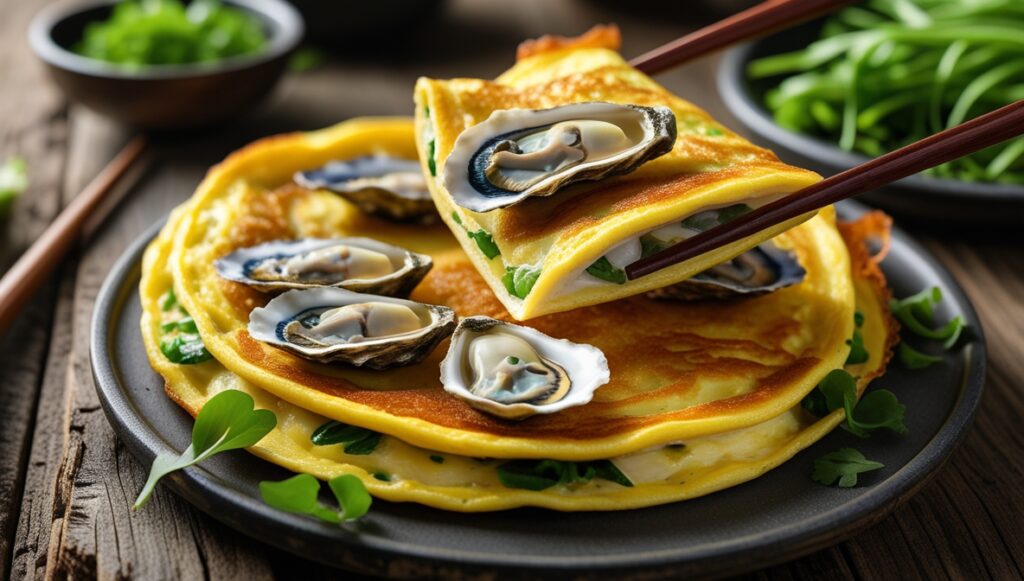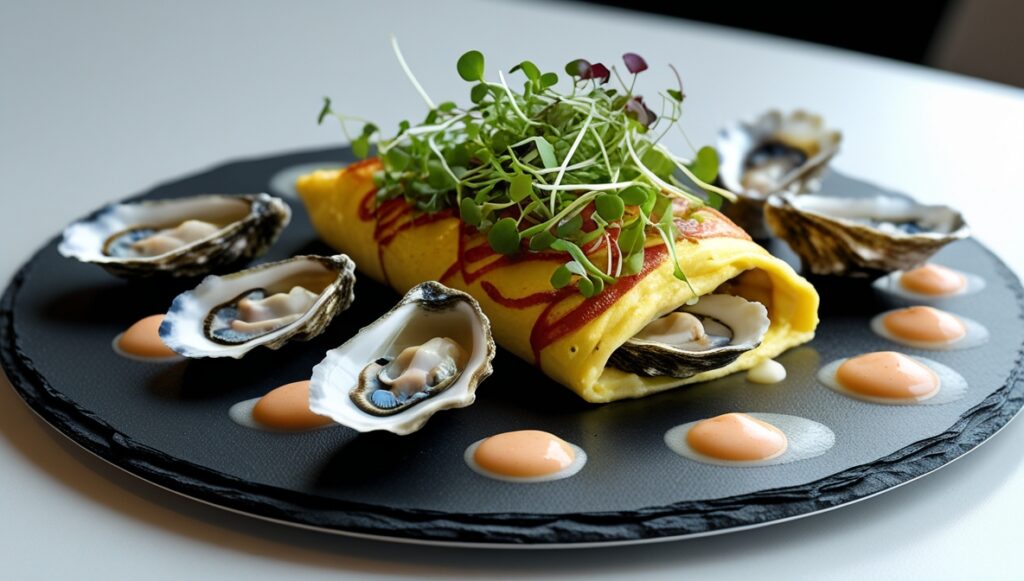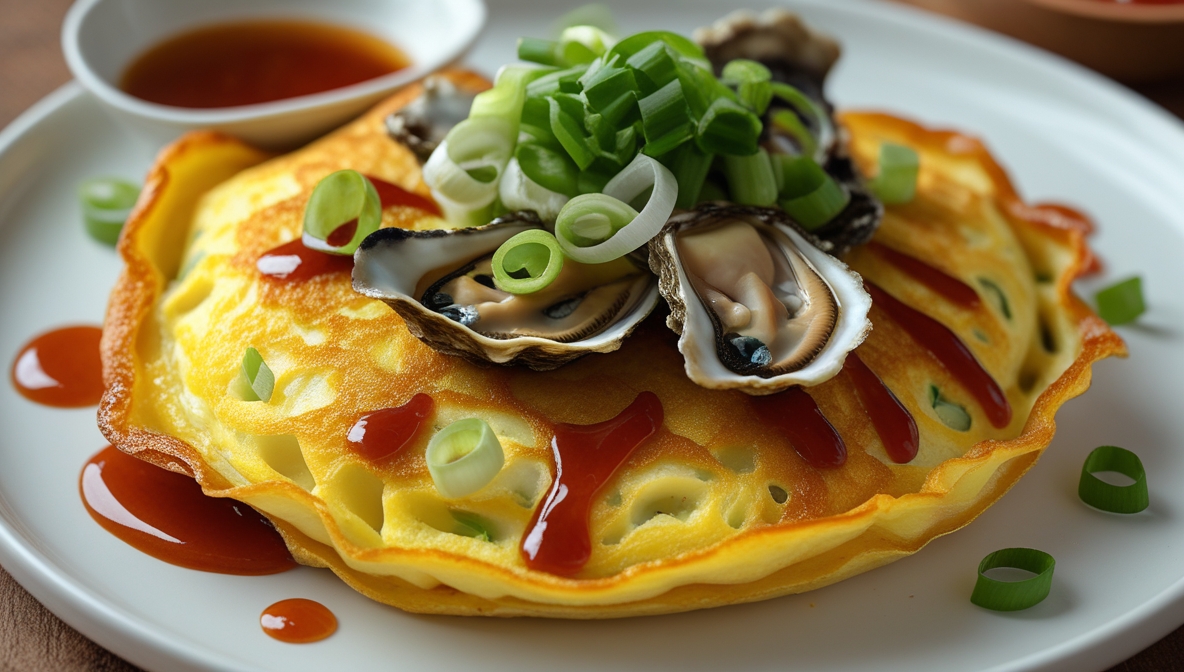Introduction
In the bustling night markets of Taiwan, one dish reigns supreme among locals and tourists alike — the Oyster Omelet. A cherished Traditional Taiwan Food, it’s known locally as “蚵仔煎” (ô-á-chian) and loved for its chewy texture, sweet-savory sauce, and plump, juicy oysters enveloped in an egg and starch batter. More than just a snack, the Oyster Omelet is a true cultural emblem and one of the Famous Foods in Taiwan that visitors make a point to try.
Why is it so iconic? The secret lies in its perfect harmony of textures and flavors — the brininess of fresh oysters, the silkiness of egg, a slightly crispy starch base, and a unique sweet-spicy sauce. Whether you’re a seafood lover or a street food adventurer, this dish is a must-have on any Taiwanese culinary journey.


History & Cultural Significance
The Oyster Omelet has historical roots in China’s Fujian Province, where early Hoklo settlers brought the dish to Taiwan during the Qing Dynasty. Thanks to the island’s abundant oysters and night market culture, it evolved into a cornerstone of Traditional Taiwan Food.
Initially favored for its affordability and satisfying nature, the Oyster Omelet quickly gained popularity across Taiwan. Today, it’s a frequent highlight at festivals, diplomatic dinners, and street food tours — celebrated worldwide as one of the Famous Foods in Taiwan.
Ingredients & Regional Variations
Key Ingredients
Fresh oysters
Eggs
Sweet potato starch or potato starch
Garlic chives or napa cabbage
Taiwanese-style sweet chili sauce
Regional Twists:
Tainan: Thicker batter, sweeter sauce
Taipei: Crispier texture, thinner omelet
Kaohsiung: Soy paste and pickled radish for bold flavor
International Variations:
Korean: Kimchi added for a spicy kick
Japanese: Bonito flakes and mayo
Vegan: Mushrooms or tofu instead of oysters
Cooking Process & Difficulty Level

Difficulty Level: Beginner to Intermediate
Best Oyster Omelet Recipe (Step-by-Step):
Rinse and season fresh oysters.
Create a starch slurry with sweet potato starch and water.
Lightly sauté greens like garlic chives.
Pour starch mixture into a hot pan.
Add beaten eggs, oysters, and veggies on top.
Flip once the bottom crisps.
Drizzle with sweet chili sauce. Serve hot.
Where to Eat Oyster Omelet in Taiwan
Here’s Best Pleace to Try if you’re visiting:
Shilin Night Market, Taipei – The most iconic place for fresh oyster omelets.
Tainan’s Garden Night Market – Home of the most authentic and traditional version.
Ay Chung Flour-Rice Noodle (Taipei) – Their oyster omelet is surprisingly popular.
Addiction Aquatic Development (Taipei) – Gourmet twist on the classic.
Liuhe Night Market, Kaohsiung – Known for rich regional flavor and variety.
Pairing with Drinks & Side Dishes
Drinks That Complement Oyster Omelet:
Taiwanese Bubble Milk Tea
High Mountain Oolong Tea
Light Lager Beer
Plum Juice
Suggested Side Dishes:
Stinky Tofu
Taiwanese Sausage
Lu Rou Fan (Braised Pork Rice)
Tempura Bites
Fun Facts & Trivia
The Oyster Omelet frequently appears in Taiwanese films and dramas.
Former president Ma Ying-jeou publicly endorsed it as a representative dish.
It’s consistently ranked in tourist polls as one of the Top 5 Famous Foods in Taiwan.
Health Benefits & Nutrition
Nutritional Benefits:
High in protein, iron, and zinc
Eggs provide essential vitamins (A, D, E, B12)
Dietary Adaptations:
Gluten-free: Use tamari
Vegan: Sub oysters with tofu or mushrooms
Low-carb: Reduce or omit starch, use almond flour instead
How to Cook at Home
Ingredients:
½ cup fresh oysters
2 eggs
2 tbsp sweet potato starch + ⅓ cup water
Handful of chopped cabbage or garlic chives
Oil for cooking
Sweet chili sauce
Instructions:
Heat oil in a pan.
Pour starch mix as the base.
Add eggs, then oysters and vegetables.
Cook both sides until golden.
Top with sauce and serve.
Pro Tips:
Use small, fresh oysters for best flavor.
Garlic in the batter adds depth.
Less starch = crispier texture.
Global Influence & Fusion Dishes
The Oyster Omelet has influenced global cuisine:
Singapore: “Orh Luak” with nearly identical preparation
Malaysia: Often includes sambal for heat
New York & London: Fusion versions with truffle or uni
Spain/Korea: Inspired tapas and egg-oyster pizzas
Comparison with Similar Dishes
Orh Luak (Singapore):
Nearly identical dish
Uses sweet potato starch
Oysters and eggs in a crispy-starchy base
Okonomiyaki (Japan):
Savory egg-based pancake
Includes cabbage and seafood
Similar cooking technique
Kimchi Jeon (Korea):
Korean-style kimchi pancake
Pan-fried with batter
Can include seafood or vegetables
Tortilla de Camarones (Spain):
Thin, crispy shrimp omelet
Uses a flour-based batter
Light texture with similar flavor notes

